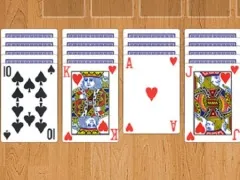2048
SIMILAR GAMES
Description
2048 - Github Games
About 2048 - Github Games
Welcome to the digital arena of 2048, a game that masterfully blends the simplicity of a puzzle with the strategic depth of a tactical challenge. Developed with an elegant design philosophy, this iteration of 2048 found on GitHub Games offers an engaging experience for both casual players and dedicated puzzle enthusiasts. At its heart, 2048 is a numerical sliding puzzle played on a 4x4 grid. The objective is deceptively straightforward: **merge tiles of the same number to create a tile with double the value**, with the ultimate goal of forming the coveted 2048 tile. Each move involves a **swipe** in one of the four cardinal directions – up, down, left, or right. When you swipe, all tiles on the board **slide as far as possible** in that direction. If two tiles with the same number collide during a slide, they **merge into a single tile** with a value equal to the sum of the two. Following each swipe, a new tile, either a **2** or a **4**, appears in a random empty spot on the grid. The game concludes when the **2048 tile** is successfully created, or when the grid is entirely filled with no possible moves remaining.
The Core Mechanics of 2048
The fundamental gameplay loop of 2048 is remarkably accessible, yet it hides layers of strategic thinking. Players are presented with a 4x4 grid that begins with two tiles, typically bearing the values of 2 or 4. The act of **swiping** is the sole input mechanism. Each swipe prompts every tile on the board to move in the chosen direction until it hits another tile or the edge of the grid. This sliding action is crucial; it’s not just about positioning, but about initiating potential **merges**. When tiles of identical numerical value meet during this sliding process, they **combine**, their values summing up to create a new, higher-valued tile. For instance, two tiles with the number 4 will merge to form a single tile with the number 8. This **exponential growth** is the engine of the game. The introduction of new tiles is a constant factor that players must account for. After every successful swipe that results in movement or merges, a new tile—almost always a 2, and occasionally a 4—materializes in one of the vacant cells. This element of randomness ensures that no two games are ever truly identical and demands **adaptive strategies** from the player.
Strategic Depth and Planning in 2048
While the interface of 2048 is minimalist, its gameplay offers a significant challenge to the player's **strategic planning and foresight**. The 4x4 grid, while seemingly small, quickly becomes a complex environment where every decision carries weight. The presence of new tiles appearing randomly means that a poorly executed move can quickly lead to a cluttered board, limiting future options and potentially ending the game prematurely. Experienced players understand the importance of **maintaining a structured grid**. A common and highly effective strategy involves keeping the **highest value tile in a corner**, often the bottom right or bottom left. This corner then acts as a focal point for merging, preventing the largest tile from becoming trapped in the middle of the board. From this corner, players aim to build a **descending chain of tile values** along the edge, flowing towards the high-value tile. For example, if the highest tile is in the bottom right, players would try to fill the bottom row with progressively smaller tiles leading up to it, then the row above, and so on. This structured approach maximizes the chances of merging larger numbers efficiently and minimizes the risk of isolating key tiles.
The Role of Algorithms and Tile Generation
The **algorithm** that governs the appearance of new tiles in 2048 is a key element contributing to the game’s replayability and challenge. While the exact probabilities might vary slightly between implementations, the general principle remains consistent: new tiles are predominantly 2s, with a smaller, but significant, chance of being a 4. This slight bias towards the smaller number is crucial. It ensures that the game doesn't escalate too quickly with high-value tiles, allowing players sufficient opportunity to manage the board. However, the randomness ensures that even the best-laid plans can be disrupted. A perfectly positioned row of high-value tiles can be rendered useless if a low-value tile appears in a critical junction, blocking a necessary merge. Understanding and anticipating these random events is part of what makes 2048 so compelling. Players learn to develop **contingency plans** and to prioritize moves that create the most flexibility, rather than simply chasing the largest immediate merge.
The Evolution and Appeal of 2048 Games
The original 2048 game, created by Gabriele Cirulli, quickly captured the imagination of the internet and spawned countless variations and adaptations. The GitHub Games version of 2048 represents one such iteration, committed to providing a clean, functional, and true-to-the-original experience. The appeal of 2048 lies in its perfect balance of simplicity and complexity. It’s a game that can be learned in seconds but mastered over a lifetime of play. The **minimalist aesthetic** removes distractions, allowing players to focus entirely on the numerical puzzle. This clarity of design is a significant factor in its enduring popularity. Furthermore, the **satisfaction of executing a perfect merge** and watching the numbers climb is inherently rewarding. The challenge of reaching that elusive 2048 tile, and for many, surpassing it to achieve even higher scores, provides a strong sense of accomplishment. The **collaborative nature of open-source development** often means that such games are refined over time, with community contributions potentially leading to bug fixes, performance enhancements, and sometimes even new gameplay twists, though the core 2048 experience remains largely sacrosanct.
Tips and Techniques for Achieving Higher Scores
To excel at 2048, players must move beyond simply reacting to the board and instead adopt a proactive, strategic mindset. One of the most universally recommended techniques is the **"corner strategy."** As previously mentioned, dedicating one corner of the 4x4 grid to house your highest tile is paramount. From this anchor point, you will build your way up. The adjacent cells along the row or column leading to this corner should ideally contain tiles of progressively lower values. This creates a **"snake" or "chain"** of numbers, facilitating effortless merges as new tiles appear and existing ones are shifted. For instance, if your highest tile is in the bottom right, you would aim to keep the bottom row filled with descending values (e.g., 1024, 512, 256, 128) and then work on filling the row above it in a similar fashion.
Maximizing Movement and Minimizing Risk
A critical aspect of advanced play involves understanding when to **restrict your movement options**. While it may seem counterintuitive, consciously limiting your available swipe directions can significantly improve your control. For example, if you are predominantly building your chain in the bottom row with the highest tile in the corner, you might choose to **avoid swiping upwards** unless absolutely necessary. This prevents higher-value tiles from being displaced from their advantageous positions and reduces the likelihood of random '2's or '4's appearing in inconvenient spots within your carefully constructed chain. The idea is to maintain the integrity of your primary merging direction, ensuring that merges of larger numbers are always possible.
The Psychology of Decision-Making in 2048
The game also presents an interesting psychological challenge. Players often face the dilemma of making a move that offers an immediate, tempting merge versus a move that, while less immediately rewarding, sets up a more advantageous board state for the future. This requires a degree of **patience and long-term vision**. It’s easy to fall into the trap of always making the move that creates the largest number right away, but this can often lead to sacrificing board control. Learning to **delay gratification** and prioritize strategic positioning over immediate numerical gain is a hallmark of skilled 2048 players. The constant pressure of new tiles appearing means that a moment’s hesitation or a suboptimal move can cascade into problems that are difficult to recover from. Therefore, **deliberate and thoughtful decision-making** is key.
Understanding Tile Distribution and Probability
While the game introduces a degree of randomness, understanding the underlying probabilities can inform your strategy. The vast majority of new tiles are 2s, with 4s appearing less frequently. This means that you will encounter many more opportunities to merge pairs of 2s than pairs of 4s. Your strategy should reflect this. Focus on creating **chains of 2s and 4s** that can easily merge into 8s and 16s, and so on. The ability to consistently merge smaller tiles is the foundation upon which larger merges are built. Do not neglect the importance of clearing out the grid. A cluttered board with many small tiles can be as detrimental as having large tiles stuck in awkward positions. **Efficiently merging smaller tiles** not only frees up space but also builds momentum, creating opportunities for larger, more impactful merges.
The 4x4 Grid: A Canvas for Strategy
The compact 4x4 grid is a crucial design element of 2048. It limits the number of available spaces, forcing players to make impactful decisions with every single move. Unlike larger grids where one might have more leeway for error, the 4x4 grid demands precision. Every empty cell is a potential sanctuary for a new tile, and every occupied cell represents a piece in a complex, ever-shifting puzzle. This confinement is what elevates 2048 from a simple matching game to a genuine test of spatial reasoning and **strategic acumen**. The interplay between the grid's limitations and the player's ambition to create ever-larger numbers is at the core of the game's enduring appeal. Mastering this limited space requires not just quick reflexes but a deep understanding of how each tile’s movement affects the entire board.
The 2048 Tile: The Pinnacle of Achievement
The ultimate goal, the **2048 tile**, serves as the symbolic peak of this numerical climb. Achieving this single tile is a significant accomplishment that requires sustained focus, strategic foresight, and a degree of luck in tile generation. However, for many dedicated players, the journey doesn't end at 2048. The game allows for continued play, pushing towards even higher totals, such as 4096, 8192, and beyond. These subsequent milestones represent an even greater mastery of the game's mechanics and a deeper understanding of its strategic nuances. The pursuit of these higher numbers fuels the **long-term engagement** with 2048, offering a persistent challenge for those who seek to truly conquer the puzzle.
Accessibility and Community in GitHub Games
The availability of 2048 on platforms like GitHub Games ensures its **accessibility** to a wide audience. Open-source projects like this often benefit from community involvement, leading to robust and well-maintained versions of classic games. This ensures that players can enjoy a polished and reliable experience. The spirit of sharing and collaboration inherent in platforms like GitHub means that 2048 is not just a game, but a testament to the power of collective development. Players can engage with the code, understand its intricacies, and contribute to its ongoing improvement, fostering a vibrant community around this deceptively simple, yet endlessly fascinating, puzzle.
Conclusion: The Enduring Allure of 2048
In summary, 2048, as presented through platforms like GitHub Games, remains a compelling and intellectually stimulating puzzle game. Its straightforward mechanics—**swiping to merge tiles**—conceal a profound strategic depth that rewards planning, foresight, and adaptability. The continuous challenge of managing a dynamic 4x4 grid, coupled with the satisfaction of creating increasingly larger numbers, ensures that each play session is both engaging and rewarding. Whether aiming for the initial 2048 tile or pushing towards unprecedented scores, the game offers a timeless appeal that continues to captivate players worldwide. Its elegant design, coupled with the inherent strategic complexity, solidifies 2048's position as a modern classic in the world of digital puzzles.
2048 invites players into a subtly complex puzzle where mathematics meets strategic maneuvering in a confined space. At its core, the game’s premise is seemingly straightforward: swipe to move and merge tiles of equal values, exponentially doubling them towards the target of a 2048 tile. Yet, beneath its minimalist interface lies a rigorous test of planning and foresight. Each swipe fills the 4×4 grid slightly, introducing new “2” or “4” tiles.
Strategic Harmony in Numbers
The essence of 2048’s challenge blooms in managing the numeric landscape. Players must cultivate a tactical harmony where each move is part of a broader strategy. The goal is to avoid isolating high-value tiles which could block potential merges. Advanced players often adopt a corner strategy, anchoring their highest value tile in a fixed position to build around. This methodical approach turns each session into a cerebral dance, where every slide, every merge, and every new tile plays into a grander scheme of spatial economy and numeric potential.
2048’s allure springs from its blend of simplicity and cognitive engagement. It doesn’t just challenge players to hit a numeric target but encourages the development of a nuanced strategy to navigate its tight, evolving board. Each game is a fresh mental workout, a puzzle that’s as addictive as it is rewarding, drawing players back to surpass their personal bests and redefine their strategic limits. This game transforms a simple grid and a series of numbers into an arena of infinite possibilities and mind-bending puzzles, proving that true challenge often comes in the most unassuming forms.
















































